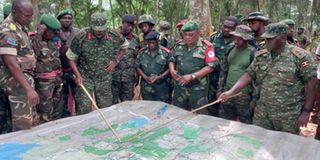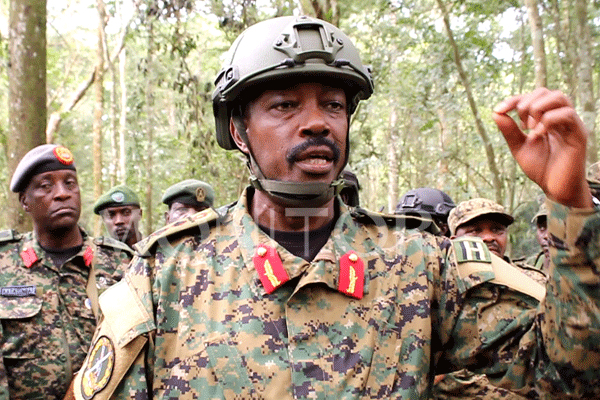Prime
ADF trapped in triangle of death, says Kayanja

UPDF soldiers and Congolese soldiers plan how to attack an ADF base inside the jungles of the DRC. Photo/Courtesy
What you need to know:
On November 30, the UPDF marched into the DR Congo through the small border town of Lamia in Bundibugyo. After six weeks of sustained bombing and counter-guerilla operations in the dense forests of North Kivu, Raymond Mujuni has been granted access to the war frontline embedded with the UPDF. This is the second in a three part series of the UPDF’s war in the eastern DR Congo
In the Semliki camp, north of Kivu, dry leaves of old trees are rustling down onto a map. The forest is dense and quiet except for the occasional walkie-talkie noise.
Soldiers, spread out in a line, are bent over on their knees sharply gazing into the trees. Some, lying ahead of the camp, covered in vegetation are hard to tell apart from the trees and bushes.
They have been here for nearly two weeks, leaving the camp each morning to walk into the jungles on the hunt for one of the DR Congo’s deadliest rebel group – the Allied Democratic Forces (ADF).
The United Nations says the group is responsible for more than 200 killings and 40,000 displaced people from the 155 attacks they carried out in 2020. The number was higher, 66,000 people displaced, when the UN group of experts authored their report seven years before then.
Maj Gen Kayanja Muhanga is scrutinising the map with his closest battle commander. Col Kasule James wears a rigid face hidden under a jungle hat. He barely speaks, when he does it is to issue commands to the soldiers on a walkie-talkie that he keeps close to his chest under an overall military uniform.
“Kikingi Iko Wapi” Kayanja asks him.
Kasule’s men, when we reach them in the camp, have just returned from a bombing campaign on the village of Kikingi. They suspect the rebels are escaping the attack through the thick forest to access Beni Town.
For weeks, this has been the routine, airforce pilots and a light motorised group bomb areas and a smaller, fitter and quicker force walks the forest to reach the bombed areas to capture casualties and interrogate them. The move had worked for the UPDF when they took charge of Kambi Ya Yua last week where the ADF, Congolese forces say, has been operating.
Kasule explains the war theatre to Muhanga:
To encircle the ADF, with a small force and geographical limitation provided by the Congolese government, Kasule’s men have formed a ‘triangle of death which stretches 170 kilometres into the eastern DRC and arcs back 100 kilometres to the Ugandan border town of Lamia. In that triangle, the UPDF constantly bomb ADF hideouts from the air and later send ground troops to mop up the battered camps.
“Our objective” Muhanga insists when we ask him about their rate of success, “is to degrade the capacity of the ADF to mobilise and carry out attacks”. But he also quickly adds, that the ultimate goal of their war in the DR Congo is to “create a conducive environment for business to thrive among the two countries”.
“They can’t escape our triangle of death” he adds.
But the triangle isn’t as neat as the commanders describe it. When we walk some kilometres in with the foot soldiers, we find a group of Ugandan engineers scouting for a new bridge over the River Semliki.
The river is an important channel laying out over 140 kilometres across Uganda and the DRC. It goes through the dense forests in which the ADF operate and, from what the Congolese soldiers insist, provides them an important trade route to transport timber, cocoa and minerals into Uganda on the shores of Lake Albert in the towns of Rwebisengo.
Their biggest chunk of evidence for ADF presence on the river was handed to them in 2017 when the rebels killed 15 UN peacekeepers and injured 53 others on a remote outpost. They had, before then, also launched an early morning attack in 2015 and killed three but in 2017, the United Nations chalked them down on their website as having conducted the deadliest attack on UN peacekeepers since 1993.
When the ADF profile was raised in the attack, the UN pressured the Congolese government to deploy troops but it wasn’t until last year that the Kinshasa government put firm boots on the ground.
“We know the MONUSCO outposts and they have been willing to help” Kayanja tells us when we ask what MONUSCO thinks of his soldiers. The UN peacekeeping force had attended a meeting in Kampala as listening posts and offered support but quickly added that it shouldn’t endanger the lives of civilians, a MONUSCO official, Bintou Keita had told the press.
On the River Semliki, as engineers measured out the options for the army on what bridge could quickly fit over the remaining steel works and collapsing concrete, we notice why, of all places, the army has its strongest and deadliest soldiers here; on one side of the bridge is a convoy of fighting equipment and on the other side is where it is supposed to be, except, if they attempt to cross it, the bridge could collapse, endangering both the troops and their equipment.
For UNRA to work on the bridge, the UPDF must do what they have been avoiding for close to six weeks now; seek parliamentary approval and budgets to operate in the DRC and for that, one of the legislators on the budget committee Ssemujju Nganda tells us: “We shall need to know exactly what it is the soldiers are doing, how long they are in the DRC and what exactly the war against ADF is.”
In the next part of the series, we explore the difficult choices the army has to make both on the battlefield and in the boardroom to buy support for the war against the ADF




